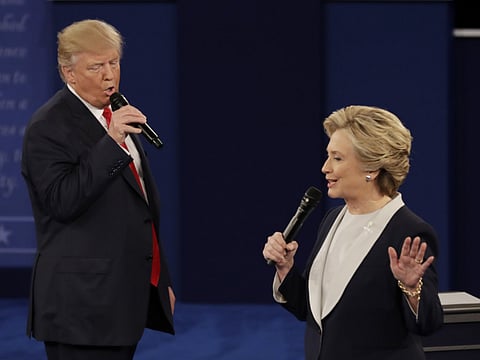First debate was the beginning of the end of Trump
The lingering question for Republicans will be: Why didn’t the meltdown of its candidate occur in the GOP primaries?

Going into the first presidential debate in the United States, Republican candidate Donald Trump’s defenders argued the proper analogy was the 1980 election when voters tuned in to see Ronald Reagan to assure themselves he wasn’t a raving nut. Reagan’s “There you go again” remark and generally genial and reasonable tone were credited with putting voters’ minds at ease. The Trump team was right to pick the 1980 Reagan-Jimmy Carter debate as a reference point — they just got the outcome wrong.
Instead of getting reassurance from Trump, many voters saw their worst fears confirmed in Trump’s first debate performance. He was rude, bullying, ignorant, angry and unpresidential. From then on, it has been downhill for Trump as independents tipped decisively for Democratic presidential candidate Hillary Clinton and many Republicans saw Trump would never be fit to be president.
Then followed a week-long meltdown (railing at Alicia Machado, a former Miss Universe), another angry debate performance on October 9 and a slew of female accusers. Unfortunately for Trump, the vast majority of Americans believe the women. In the Washington Post/ABC poll, some 68 per cent of voters believe he has made “unwanted sexual advances” towards women.
There is no such thing as 100 per cent certainty, but barring a nearly unimaginable meltdown in the last debate or a new, all-consuming Clinton scandal, she is going to win the presidency by a comfortable margin. We were among those marvelling in September (or more accurately, flabbergasted) that the race was so close. In retrospect, many voters may simply have been giving Trump one final chance — or putting off the unpleasant decision that, yes, they were going to have to vote for Clinton since she is far and away, they were reminded in the debate, the lesser of the two evils.
Once Clinton hit the tipping point, every group not nailed down (e.g., the alt-right) fell into her lap. That’s essentially what the latest Quinnipiac battleground poll shows: “Independent likely voters shift to Democrat Hillary Clinton, giving her the lead over Republican Donald Trump in the critical swing states of Colorado, Florida and Pennsylvania and moving her into a tie with Trump in Ohio ... Clinton also has double-digit leads among women likely voters and leads of 28 to 76 percentage points among non-white voters.” Seventy-six points?! Yup, that is the spread in Pennsylvania (72 to 17 per cent) among non-white voters.
Support for Trump among Republicans ranges from a low of 84 per cent in Colorado to a high of 89 per cent in Ohio, all of which fall well short of the 93 per cent of Republicans that Mitt Romney got in 2012. Trump actually manages to lose the white vote in Colorado (41 to 43 per cent) and leads by only 6 among whites in Pennsylvania. Nationally, Romney won the white vote by 20 points in 2012.
Shifting to a national basis, Clinton is up roughly 8 points in the Pollster.com average and 7 points in the RealClearPolitics average. Her favourability has improved somewhat (43 favourable/53 unfavourable in Pollster.com compared to Trump’s 33-63 split) — although the latest email revelations have not yet been fully factored in. Among the major forecasters, her chance of winning the presidency ranges from 88 per cent to 97 per cent.
We see in the latest national CBS poll (showing Clinton ahead by 11 points in a one-on-one match-up) the same disastrous trends for Trump evident in state polling:
“Trump has lost some support among members of his own party. Seventy-seven per cent of Republicans support him now, down from 84 per cent before the Access Hollywood tape and allegations of sexually aggressive behaviour surfaced.
“Hillary Clinton opened up a wide lead among women voters after the first presidential debate and she continues to get strong support from that group, leading Trump by 19 points among them. If this advantage holds on Election Day, it would be the largest margin for a Democrat among women going back to 1972 when exit polls were first conducted. Trump has lost some ground with men and older voters. He now has just a two-point edge among men; he led by 11 points earlier this month ... Trump leads with white voters overall, including white men, but the race is close among white women. Republican Mitt Romney won white women by 14 points in 2012, according to exit polls.”
The lingering question for Republicans will be: Why didn’t the Trump meltdown occur in the GOP primaries? Right-wing bitter-enders claim there was a media conspiracy to keep the sexual assault scandals under wraps until he was the nominee. Others rail at Trump’s GOP opponents for not uncovering the women’s stories earlier. (If the women were not going to step forward until the Access Hollywood tape surfaced, however, it’s hard to see how campaign opposition researchers could have found them.) Other Republicans point to the huge field of 17 candidates that let Trump escape focused scrutiny during the debates and divided the not-Trump vote.
Looked at differently, however, the ghastly possibility remains that if these women had come forward in the primaries, the GOP would still have nominated him. After all, in continuing to defend Trump, the large majority of the GOP electorate demonstrates it has become indifferent to rotten, misogynist, racist behaviour — so long as the rotten, misogynist, racist candidate is one of their own.
In any event, the dam has burst, reassuring many dismayed voters that the majority of Americans haven’t lost their collective minds and sense of decency.
— Washington Post
Jennifer Rubin writes the Right Turn blog for the Washington Post, offering reported opinion from a conservative perspective.
Sign up for the Daily Briefing
Get the latest news and updates straight to your inbox



